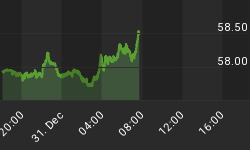UNEDITED
Two economic reports released last week showed that economic activity continued to expand in May. The employment report from the Bureau of Labor showed another large gain in the workforce. Not only did the report show that there was 225,000 jobs added in May, but the increase in April was revised from 288,000 to 346,000. Over the past three month, 948,000 workers have been added. Even the manufacturing sector has added 84,000 jobs. The non-manufacturing ISM survey fell 2.4 points to 66, but remained significantly above the 50 level indicating continued expansion. Prices paid soared 5.8 points to 74.4, eclipsing the high set in March 2000 when the prices sub-index reached 69.6. The employment component rose 1.8 points to 56.3. This was the highest level since November 1997.
Perhaps the first cracks in the expanding economy have started to appear in one of the strongest sectors. Dominion Homes, a small builder located in Ohio, lowered guidance for the second-quarter. In a press release, the company said "Gross unit sales for April and May are off 15%, and increases in cancellations have further impacted net sales which are down 35% below the same months last year." The company blamed higher interest rates. It said that 70% of its customers are first-time home buyers, "who in an increasing interest rate environment, either delay their buying decision, or have a harder time qualifying for a mortgage.
At this point, analysts are attempting to dismiss the weakness in Dominion as company specific weakness. The continued strength in purchase applications indicates that the industry as a whole remains robust. The Mortgage Bankers Association purchase application index dropped about 27 points to 432.2. While the index is off about 15% from the high set earlier this year, the index remains higher than any level prior to 2003. The refinance index dropped over 200 points last week to 1,363.2, the lowest level since May 31, 2002. The average loan size has increased about 7.5% since last year with growth being driven from the size of loans to purchase a house. The average loan size for purchases has increased by 9.7% since the beginning of June 2003, while the average refinancing has dropped by 2.4%. Additionally, the percent of applications that are for adjustable rate mortgages remains near historical highs at 34.6%.
While refinancings have tumbled, the amount of home equity lines of credit has soared. A Wall Street Journal story this week, Equity Lines Hit Record As Rates Rise, highlighted this growing market. The story reported that J. P. Morgan Chase & Co. reported that home-equity volume increased 51% during the first quarter and Wells Fargo and National City said that March and April were record months for their home-equity business. One concern the article addressed was that home equity loans are typically adjustable monthly and tied to the prime rate, which will rise when the Federal Reserve starts raising interest rates.
The Tribune Co., publisher of the Chicago Tribune and Los Angles Times, announced it will not achieve previous articulated forecasts. The newspaper company reported that while most of the weakness was based on a few papers including the Los Angles Times. It also said that retail advertising was flat with strength in food advertising and offset by weakness in department stores, home furnishing, and electronics. Strength was also reported in the financial and travel categories. High-tech and entertainment were also mentioned as weak. Classified advertising rose 11% due to double-digits gains in help wanted (25%) and real estate (14%). Automotive advertising fell 1%. The company said it will cut costs to increase profitability. Some of these measures include reducing its workforce and conserving newsprint.
Union Pacific also said it will not achieve Wall Street earnings estimates for the second-quarter partially due to rising fuel prices and other costs. But an expected surge in traffic at the largest U.S. railroad company strained crews and led to delays. Union Pacific is adding 4,200 workers this year and acquiring over 600 locomotives to handle the increased traffic.
On Wednesday, the Semiconductor Industry Association increased their forecasts for sales growth this year to 28.6% to $214 billion. This will surpass the previous sales record of $204 billion set in 2000. It should be remembered that the forecasts for 2003 sales back in June, 2000 was $312 billion. This was about double the $166 billion realized in 2003. Of course there are other indications that the technology is currently expanding. Texas Instruments slightly increased its forecasts for second-quarter EPS by rising the low-end of the range by a penny and adjusting the midpoint of the revenue guidance from $3.21 billion to $3.23 billion. The midpoint would represent growth of 38% from the second quarter last year. Investors were hoping for a larger increase after Intel guided revenues and earnings higher the previous week.
Johnson Electric, the world's second largest small motor manufacturer, announced that it will increase prices to offset the effect of rising steel and copper prices are having on its profitability. The company also mentioned that shipping costs have increased.
The second half of the year is shaping up to be interesting. Part of the strength of the economy has been the fiscal stimulus resulting from the tax cut last year. The tax-cut lowered the marginal tax rates which went into effect at the end of June last year. The lower marginal tax rates went into effect after the tax bill past in May 2003. The lower tax rates boosted worker's after-tax paycheck, which in turn boosted customer spending. This will anniversary during the second half of the year. Investors also have to contend with a plethora of anecdotal evidence of inflation. Plus, the Federal Reserve will be raising interest rates.
















